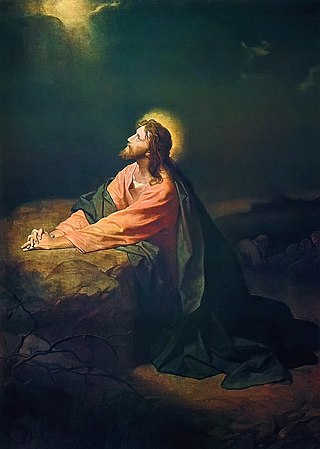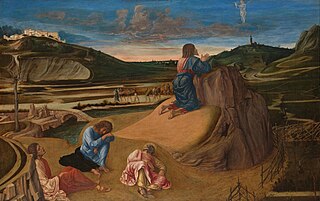
Andrea Mantegna was an Italian painter, a student of Roman archeology, and son-in-law of Jacopo Bellini.

The agony in the Garden of Gethsemane is an episode in the life of Jesus, which occurred after the Last Supper and before his betrayal and arrest, all part of the Passion of Jesus leading to his crucifixion and death. This episode is described in the three Synoptic Gospels in the New Testament. According to these accounts, Jesus, accompanied by Peter, John and James, enters the garden of Gethsemane on the Mount of Olives where he experiences great anguish and prays to be delivered from his impending suffering, while also accepting God's will.

The Lamentation of Christ is a painting of about 1480 by the Italian Renaissance artist Andrea Mantegna. While the dating of the piece is debated, it was completed between 1475 and 1501, probably in the early 1480s. It portrays the body of Christ supine on a marble slab. He is watched over by the Virgin Mary, Saint John and St. Mary Magdalene weeping for his death.

The Pinacoteca di Brera is the main public gallery for paintings in Milan, Italy. It contains one of the foremost collections of Italian paintings from the 13th to the 20th century, an outgrowth of the cultural program of the Brera Academy, which shares the site in the Palazzo Brera.

Distemper is a decorative paint and a historical medium for painting pictures, and contrasted with tempera. The binder may be glues of vegetable or animal origin. Soft distemper is not abrasion resistant and may include binders such as chalk, ground pigments, and animal glue. Hard distemper is stronger and wear-resistant and can include casein or linseed oil as binders.

The Triumphs of Caesar are a series of nine large paintings created by the Italian Renaissance artist Andrea Mantegna between 1484 and 1492 for the Gonzaga Ducal Palace, Mantua. They depict a triumphal military parade celebrating the victory of Julius Caesar in the Gallic Wars. Acknowledged from the time of Mantegna as his greatest masterpiece, they remain the most complete pictorial representation of a Roman triumph ever attempted and together they form the world's largest metric area of Italian Renaissance paintings outside Italy.
The decade of the 1460s in art involved some significant events.

This article about the development of themes in Italian Renaissance painting is an extension to the article Italian Renaissance painting, for which it provides additional pictures with commentary. The works encompassed are from Giotto in the early 14th century to Michelangelo's Last Judgement of the 1530s.

The Council of Mantua of 1459, or Congress of Mantua, was a religious meeting convoked by Pope Pius II, who had been elected to the Papacy in the previous year and was engaged in planning war against the Ottoman Turks, who had taken Constantinople in 1453. His call went out to the rulers of Europe, in an agonized plea to turn from internecine warfare to face Christendom's common enemy.

The San Zeno Altarpiece is a polyptych altarpiece by the Italian Renaissance painter Andrea Mantegna created around 1456–1459. It remains in situ in the Basilica di San Zeno, the main church of the Northern Italian city of Verona. Mantegna's style mixes Greco-Roman classical themes along with Christian subjects in this altarpiece. The central panel, along with the three paintings that comprise the predella, were taken in 1797 by the French. While the main, central scene was returned by the French to Verona in 1815, the three predella paintings in Verona today are copies, since the original ones remain in France at the Louvre (Crucifixion) and in the Musée des Beaux-Arts in Tours. The paintings are made with tempera on panel; not oil as mistakenly identified in one source.

The Agony in the Garden is an early painting by the Italian Renaissance master Giovanni Bellini, who created it ca.1459–1465. It is a tempera painting on panel and is now in the National Gallery, London.

Giovanni Antonio da Brescia was an Italian engraver of northern Italy, active in the approximate period 1490–1519, during the Italian Renaissance. In his early career he used the initials "Z.A." to sign some twenty engravings, and until recently Zoan Andrea was regarded as a distinct printmaker; it is now realized that they are the same person, and the "Z.A." stood for Giovanni Antonio, "Zovanni" being a north Italian spelling. Around 1507 he began to use formulae such as "IO.AN.BX.", and signed some prints more fully. The real Zoan Andrea was a very obscure painter, documented as working in Mantua in the 1470s, who produced no engravings.

Francesco Bonsignori, also known as Francesco Monsignori, was an Italian painter and draughtsman, characterized by his excellence in religious subjects, portraits, architectural perspective and animals. He was born in Verona and died in Caldiero, a city near Verona. Bonsignori's style in early period was under the influence of his teacher Liberale da Verona. After becoming the portraitist and court artist to the Gonzaga family of Mantua in 1487, his style was influenced by Andrea Mantegna, who also worked for Francesco Gonzaga from the 1480s. They collaborated to execute several religious paintings, mainly with the theme of Madonna and Child. The attribution of theportrait of a Venetian Senator was debatable until the last century because of the similarity in techniques used by Bonsignori and his teacher Mantegna. During the phase of his career in Mantua, there is an undocumented period between 1495 and July 1506 with no official record regarding his activities by the court of Mantua. Bonsignori's late style was decisively influenced by Lorenzo Costa in terms of form and color. He produced his last monumental altarpiece the Adoration of the Blessed Osanna Andreasi in 1519 shortly before his death.

The Transfiguration of Jesus has been an important subject in Christian art, above all in the Eastern church, some of whose most striking icons show the scene.

The Agony in the Garden is a small painting by William Blake, completed as part of his 1799–1800 series of Bible illustrations commissioned by his patron and friend Thomas Butts. The work illustrates a passage from the Gospel of Luke which describes Christ's turmoil in the Garden of Gethsemane before his arrest and Crucifixion following Judas's betrayal. In Blake's painting a brilliantly coloured and majestic angel breaks through the surrounding darkness and descends from a cloud to aid and physically support Jesus in his hour of agony. The work is dominated by vertical lines, formed both from the trees and from the two arms of the angel. Two inner lines converge on Christ's palms, evoking the nails driven through him during his crucifixion.

Agony in the Garden is a small 1524 oil on panel painting of the Agony in the Garden by Correggio, now at Apsley House in London.

The Holy Family with the Infant Saint John the Baptist is a tempera on canvas painting measuring 71 cm by 50.5 cm. It is attributed to Andrea Mantegna, dated to around 1500 and now held in the National Gallery, London. Due to its poor conservation, the autograph is unclear, so some scholars do not directly attribute it to Mantegna. Though, those that do argue its idea and format definitely refer to autographed works by him.

The Pinacotecta Nazionale is an art gallery in Ferrara, Emilia-Romagna, Italy. It is located on the piano nobile of the Palazzo dei Diamanti, a work of Renaissance architecture by Biagio Rossetti, commissioned by Leonello d’Este in 1447. Not to be confused with the Civic Museum on the lower floor, which has hosted temporary exhibitions of contemporary art since 1992, the Pinacoteca houses a collection of paintings by the Ferrarese School dating from the thirteenth to the eighteenth centuries. It was founded in 1836 by the Municipality of Ferrara after Napoleon's widespread dissolution of churches threatened the protection of important public artworks. The gallery is formed as much around notable northern Italian painters as it is around the exquisite interior decoration of the palace itself, together with remnants of frescoes from local churches and later acquisitions from the Sacrati Strozzi collection.

Lamentation of Christ is an oil painting created by Greek painter Nikolaos Kantounis. He was a painter and teacher. He was a priest. His teachers were famous painters Ioannis Korais and Nikolaos Koutouzis He was a representative of the Heptanese School. His artwork was created during the Neoclassical and Romantic periods in Greek art. He was active on the island of Zakynthos from 1782–1834. He was one of the earliest members of the modern Greek art period. Over 164 of his paintings have survived. He is known for painting many portraits. He was a member of the secret organization for Greek Independence called the Filiki Eteria. Towards the end of his life he was honored with the rank of Grand Sakellarios.
The Agony in the Garden is an early painting by the Italian Renaissance master Giovanni Bellini, who painted it around 1458-60. It is in the National Gallery, London. It is painted in egg tempera on wood panel, measuring 80.4cm by 127cm. The painting depicts a biblical scene following the Last Supper wherein Judas has betrayed Christ and now pursues him where he prays in the Garden of Gethsemane, accompanied by the disciples Peter, James, and John. The piece bears visual similarity to the version by Andrea Mantegna, Bellini's brother-in-law, meaning the two paintings are often studied in the context of one another. The painting utilizes many common elements of Renaissance symbolism in order to foreshadow Christ's crucifixion and the presence of God in the piece.


















